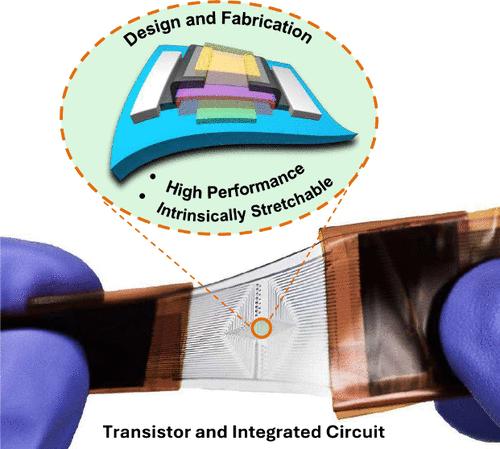Design Considerations and Fabrication Protocols of High-Performance Intrinsically Stretchable Transistors and Integrated Circuits
IF 16
1区 材料科学
Q1 CHEMISTRY, MULTIDISCIPLINARY
引用次数: 0
Abstract
Intrinsically stretchable electronics represent a significant advancement in wearable and implantable technologies, as they offer a unique advantage by maintaining intimate tissue contact while accommodating movements and size changes. This capability makes them exceptionally well-suited for applications in human-machine interfaces, wearables, and implantables, where seamless integration with the human body is essential. To realize this vision, it is important to develop soft integrated circuits for on-body signal processing and computing. Our previous work has focused on developing high-density, intrinsically stretchable transistors capable of delivering high drive current, high-speed performance, and facilitating large-scale integrated circuits. These breakthroughs were achieved through a comprehensive and synergistic approach that encompassed material innovation, meticulous fabrication process design, precise device engineering, and strategic circuit design. Here we provide a comprehensive yet detailed description of these protocols, including design principles, material preparation, fabrication processes, and troubleshooting. These protocols are to empower other researchers to reproduce our developed processes, thus fostering further advancements in stretchable electronics. Specifically, we present in this article an enhanced protocol with explanations, complemented by photographs and instructional videos. This resource aims to bridge the knowledge gap and provide invaluable insights for researchers interested in developing high-performance intrinsically stretchable transistors and integrated circuits. We hope this helps to enable future advancements in the field of intrinsically stretchable electronics.

高性能本征可拉伸晶体管和集成电路的设计考虑因素和制造规程
本征可拉伸电子器件是可穿戴和植入技术的一大进步,因为它们具有独特的优势,既能保持与组织的亲密接触,又能适应运动和尺寸变化。这种能力使其非常适合应用于人机界面、可穿戴设备和植入设备中,在这些应用中,与人体的无缝整合至关重要。要实现这一愿景,必须开发用于人体信号处理和计算的软集成电路。我们之前的工作重点是开发能够提供高驱动电流、高速性能和促进大规模集成电路的高密度、本质上可拉伸的晶体管。这些突破是通过全面的协同方法实现的,其中包括材料创新、精细的制造工艺设计、精确的器件工程和战略性电路设计。在此,我们对这些规程进行了全面而详细的介绍,包括设计原理、材料制备、制造工艺和故障排除。这些协议旨在帮助其他研究人员复制我们开发的工艺,从而促进可拉伸电子学的进一步发展。具体来说,我们在这篇文章中介绍了带有解释的增强协议,并辅以照片和教学视频。该资源旨在弥补知识差距,为有志于开发高性能本征可拉伸晶体管和集成电路的研究人员提供宝贵的见解。我们希望这有助于推动本征可拉伸电子学领域的未来发展。
本文章由计算机程序翻译,如有差异,请以英文原文为准。
求助全文
约1分钟内获得全文
求助全文
来源期刊

ACS Nano
工程技术-材料科学:综合
CiteScore
26.00
自引率
4.10%
发文量
1627
审稿时长
1.7 months
期刊介绍:
ACS Nano, published monthly, serves as an international forum for comprehensive articles on nanoscience and nanotechnology research at the intersections of chemistry, biology, materials science, physics, and engineering. The journal fosters communication among scientists in these communities, facilitating collaboration, new research opportunities, and advancements through discoveries. ACS Nano covers synthesis, assembly, characterization, theory, and simulation of nanostructures, nanobiotechnology, nanofabrication, methods and tools for nanoscience and nanotechnology, and self- and directed-assembly. Alongside original research articles, it offers thorough reviews, perspectives on cutting-edge research, and discussions envisioning the future of nanoscience and nanotechnology.
 求助内容:
求助内容: 应助结果提醒方式:
应助结果提醒方式:


